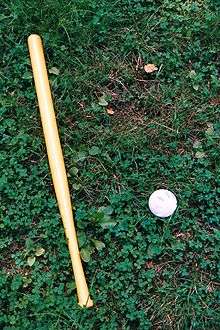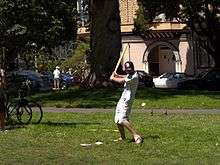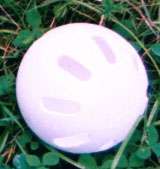Wiffle ball
The game of Wiffle ball is a variation of baseball.[1] The Wiffle ball is designed for indoor or outdoor play in confined areas. The game is played using a perforated, light-weight, resilient plastic ball and a long, typically yellow, plastic bat.[2]

History
Miniature versions of baseball have been played for decades, including stickball, improvised by children, using everything from rolled up socks to tennis balls. The ball most commonly used in the game was invented by David N. Mullany at his home in Fairfield, Connecticut in 1953[3] when he designed a ball that curved easily for his 12-year-old son. It was named when his son and his friends would refer to a strikeout as a "whiff". The Wiffle Ball is about the same size as a regulation baseball, but is hollow, lightweight, of resilient plastic, and no more than 1/8 inch (3 mm) thick. One half is perforated with eight .75-inch (19 mm) oblong holes; the other half is non-perforated. This construction allows pitchers to throw a tremendous variety of curveballs and risers.
In April 2011, the government of the State of New York proclaimed that wiffle ball, as well as kickball, freeze tag and dodgeball were "unsafe" and a "significant risk of injury" for children, and declared that any summer camp program that included two or more of such activities would be subject to government regulation.[4] The story became a frequent source of ridicule and amusement, with Parenting.com sarcastically commenting, "According to new legislation introduced in New York State, to survive classic schoolyard games like capture the flag is to cheat death."[5] Wiffle ball executives originally thought the order was a joke. The company has never been sued over safety issues in its 50+ year history.[6] The disapproval of people from across the nation pressured the New York legislature to remove wiffle ball and other entries such as archery and scuba diving from the list of high-risk activities, that require state government oversight.[7]
Game

The game became popular nationwide by the 1960s,[8] and is played in backyards, on city streets, and on beaches. The game is similar to baseball, and is designed for 2–10 players. A single game of Wiffle ball consists of 7 innings or 60 minutes whichever is earliest. [9][10]

Tournaments
Tournaments have been the driving force in modern wiffle ball and have been held in the United States and Europe since 1977. That year, Rick Ferroli began holding tournaments in his backyard tribute to Fenway Park in Hanover, Massachusetts.[11] In 1980, the World Wiffleball Championship was established in Mishawaka, Indiana by Jim Bottorff and Larry Grau. With the explosion of the Internet in the 1990s, there are now hundreds of Wiffle ball tournaments played in the United States, most in the same place every year, with a few tournament "circuits". The World Wiffleball Championship remains the oldest tournament in the nation, having moved to the Chicago suburbs in 2013, after introducing regional stops over three decades in Baltimore; Los Angeles; Indianapolis; Eugene, Oregon; and Barcelona, Spain.[12] The tournament is featured at #27 in the book, "101 Baseball Places to Visit Before You Strike Out."[13]
There is a national fast pitch tournament every summer held in Morenci, Michigan as well. This tournament determines which league is the best in the country. It is called the NWLA Tournament.[14]
Fields
Some wiffle ball players have built fields to resemble major league ballparks. Thomas P. Hannon, Jr. authored a book, Backyard Ball, on his experiences building a smaller version of Ebbets Field. Patrick M. O'Connor wrote a book, Little Fenway, about building his versions of Fenway Park and Wrigley Field.[15] But not all wiffle ball fields have been modeled from major league ball parks. Some have created original fields, Strawberry Field in Encino, California being the most exquisite. Rick Messina spent over $700,000 constructing Strawberry Field, which features lights for night games, bleachers, and a press box.[16] He also converted a neighboring house into a clubhouse/pub.[17]
Building fields can lead to controversy and legal issues. In 2008, The New York Times published an article about Greenwich, Connecticut teenagers who were forced by the city to tear down a wiffle ball field they had built because of neighbor complaints.[18]
In popular culture
In his book The Complete Far Side, cartoonist Gary Larson reproduces a letter he received after including a "wiffle bat" in his cartoon. The letter contains language from Wiffle Ball Incorporated's attorneys: "In the future, when you use the brand name WIFFLE, the entire brand should be capitalized, and it should only be used in reference to a product currently manufactured by The Wiffle Ball, Inc."[19][20]
In science, it is frequently used by marine biologists as a size reference in photos to measure corals and other objects.[21][22]
References
- http://www.wiffle.com/pages/game_rules.asp?page=game_rules
- http://www.wiffle.com/pages/game_rules.asp?page=game_rules
- "What's 50, Curvy And Full of Air?; It's the Wiffle Ball, Still Popular, Holes and All". The New York Times. August 14, 2003. Retrieved August 14, 2014.
- Blain, Glenn (April 19, 2011). "Classic kids games like kickball deemed "unsafe" by state in effort to increase summer camp regulation – New York Daily News". Articles.nydailynews.com. Archived from the original on December 24, 2011. Retrieved February 1, 2012.
- "Playground Games Deemed Unsafe for Kids". Parenting.com. April 20, 2011. Retrieved February 1, 2012.
- Blain, Glenn (April 20, 2011). "Wiffle Ball creators call scrapped New York state listing of backyard game as dangerous 'ridiculous' – New York Daily News". Articles.nydailynews.com. Retrieved February 1, 2012.
- "State Officials Back Off Regulating Freeze Tag, Kids' Games". NBC New York. April 19, 2011. Retrieved February 1, 2012.
- "A Brief History of Wiffle Ball".
- "Wiffle Ball Rules & Field Dimensions".
- "The Wiffle Ball, Inc. – A Brief History". www.wiffle.com. Retrieved March 29, 2017.
- "Wiffleball: A Connecticut invention that keeps giving back".
- "World Wiffle Ball Championship".
- "101 Baseball Places to Visit Before You Strike Out".
- "Official Site of the NWLA Tournament". NWLA Tournament. Retrieved June 20, 2018.
- "Official Site of the Little Fenway Wiffle Ball Field Located in Jericho, VT". Little Fenway. Archived from the original on February 2, 2012. Retrieved February 1, 2012.
- "Wiffle Ball Hits Home – Los Angeles Times". Los Angeles Times. October 11, 2000. Retrieved February 1, 2012.
- Wiffle Ball: The Ultimate Guide by Michael Hermann, pages 107–110
- Peter Applebome (July 10, 2008). "Our Towns – Build a Wiffle Ball Field and Lawyers Will Come". The New York Times. Greenwich, Connecticut. Retrieved February 1, 2012.
- "How the Wiffle Ball Came to Be".
- Larson, Gary (2003). The Complete Far Side. 2. Andrews McMeel Publishing. p. 71. ISBN 0-7407-2113-5.
- "Live Webcams: Scientists Studying Corals Damaged by Oil in the Gulf of Mexico". Penn State Science. June 25, 2014.
- "PHOTOS & VIDEO". Nautilus Live. Retrieved April 30, 2015.
External links
| Wikimedia Commons has media related to Wiffle Ball. |